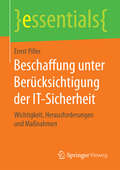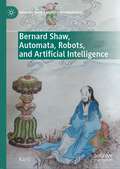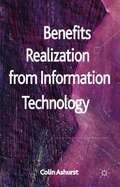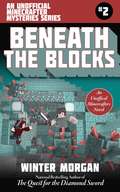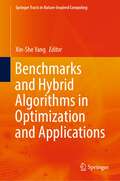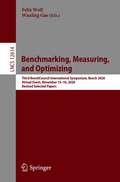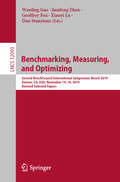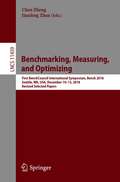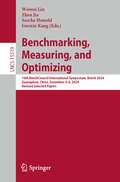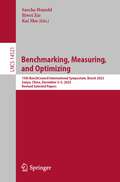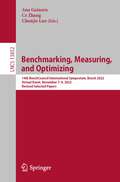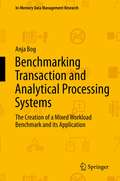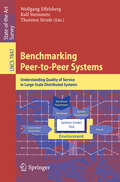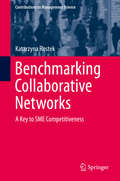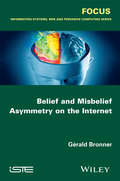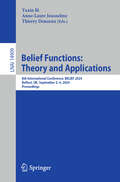- Table View
- List View
Beschaffung unter Berücksichtigung der IT-Sicherheit: Wichtigkeit, Herausforderungen und Maßnahmen (essentials)
by Ernst PillerErnst Piller gibt praktische Hinweise zum Beschaffungsvorgang von IT-sicherer Soft- und Hardware für die eigene Infrastruktur bzw. die Produktion. Dabei beschränkt sich ‚Hardware‘ nicht nur auf IKT-Produkte, sondern impliziert auch alle Geräte, Maschinen, Steuerungen, Fahrzeuge und Produktionskomponenten aus allen Branchen, die eine Software enthalten. Der Autor behandelt Themen wie IT-Sicherheitsanforderungen, Vertrauen in Hersteller, beschaffungsrelevante Informationssysteme für IT-Sicherheit und Gütezeichen. Abgerundet wird das essential mit der Vorstellung einer herstellerunabhängigen und kostenfreien Plattform zur Unterstützung des Beschaffungsprozesses für den Einkauf von Soft- und Hardware unter Berücksichtigung der IT-Sicherheit.
Bernard Shaw, Automata, Robots, and Artificial Intelligence (Bernard Shaw and His Contemporaries)
by Kay LiThis project is the first to explore how Bernard Shaw intersects constructively with automata, robots and artificial intelligence (AI). Shaw was born in the golden age of the automaton. His Bible on the Life Force and Creative Evolution, Back to Methuselah, was written when Karel and Josef Čapek coined the word “robot.” Shaw’s life ran in parallel with the rise of AI, and the big names in AI were his contemporaries. Moreover, empirical analyses of Shavian texts and images using AI uncovers possibilities for new interpretations, demonstrating how future renditions of his works may make use of these advanced technologies to broaden Shaw’s audience, readership and scholarship.
Beowulf: A Ladybird Expert Book (The Ladybird Expert Series #26)
by Janina RamirezPart of the ALL-NEW LADYBIRD EXPERT SERIES'This accessible illustrated guide is a great introduction to the story, its origins and its enduring legacy' BBC HISTORY- Which is more terrifying - a monster or its mother? - Why did Berserkers run naked into battle? - How was the story of Beowulf almost lost forever?PLUNGE into the adventures of Beowulf, the 6th Century hero who defeated the monster Grendel, became king of his people, and slayed a tremendous dragon. Surviving in a single, burnt manuscript, Beowulf continues to entrance readers and inspire major works of fantasy today.WARRIORS. MONSTERS. DRAGONS. GOLD.Janina Ramirez's Beowulf is an accessible and authoritative guide to the spellbinding world and daring feats of a poem remembered through the centuries.
Benutzerzentrierte Unternehmensarchitekturen: Ein portfolio-orientierter Ansatz zur Geschäftstransformation mit ArchiMate®
by Dimitris Karagiannis Christoph Moser Anke HelmesUnternehmensarchitektur-Management unterstützt die Planung und Durchführung von Geschäftstransformation. Existierende Ansätze können in portfolio- und projekt-orientierte Ansätze eingeteilt werden. Die Synthese dieser Ansätze bietet das Beste aus beiden Welten. Das Buch stellt den kombinierten Ansatz vor. Der Inhalt gliedert sich in ausgewählte Best-Practice-Szenarien. Der Fokus liegt jeweils auf dem Thema Benutzererfahrung – ein Schwerpunkt, der in Transformationsprojekten oftmals vernachlässigt wird.Zur Evaluierung von Unternehmensarchitekturen aus Sicht der Benutzer steht unter ww.omilab.org/usercentricassessment ein Online-Service zur Verfügung.
Bent Functions and Permutation Methods: Binary and Multiple-Valued Bent Functions (Synthesis Lectures on Engineering, Science, and Technology)
by Jaakko Astola Claudio Moraga Radomir S. Stanković Milena StankovićThis book discusses in a uniform way binary, ternary, and quaternary bent functions, while most of the existing books on bent functions refer to just binary bent functions. The authors describe the differences between binary and multiple-valued cases and the construction methods for bent functions are focused on the application of two types of permutation matrices. These matrices are derived from a class of differential operators on finite groups and Fast Fourier transform algorithms, respectively. The approach presented is based on the observation that given certain bent functions, many other bent functions can be constructed by manipulating them. Permutations are possible manipulations that are easy to implement. These permutations perform spectral invariant operations which ensure that they preserve bentness.
Benny the Blue Whale: One Author's Descent into the Madness of AI
by Andy StantonAI is changing the world at frightening speed. A bestselling author decides to find out more… &‘Something profound and utterly brilliant is going on… hilarious.&’ THE TIMES Is ChatGPT the end of creative industries as we know them? An ethical quagmire from which there is no return? A threat to all our jobs, as we keep hearing on the news? Bestselling children&’s author Andy Stanton has made a career out of writing differently – from the unconventional &‘hero&’ of his bestselling Mr Gum series to his penchant for absurdist plots, his children&’s books are anything but formulaic. When a friend introduces him to ChatGPT, the new large language chatbot, Andy is as sceptical as he is curious. Can this jumble of algorithms really mimic the spontaneity of human thought? Could it one day replace human authors like him for good? And are we soon to be ruled over by despotic robot overlords? He decides there&’s only one thing for it – he must test this bot&’s capabilities. Eventually, he settles on a prompt that will push the algorithm to its creative limits: &‘tell me a story about a blue whale with a tiny penis.&’ Chaos ensues. What follows is a surprising and illuminating battle between Andy and ChatGPT that maybe, just maybe, might help us all understand AI a little bit better. Join Andy and his beleaguered AI lackey on a rollicking metafictional journey through the art of storytelling. Presenting his prompts and the AI-generated narrative alongside extensive commentary, Stanton provides a startling paean to the art of a good story and boundless human creativity. Hopeful and hilarious, Benny the Blue Whale provides a joyfully anarchic meditation on AI, literature and why we write. *** A WATERSTONES AND NEW SCIENTIST BEST BOOK OF 2023 &‘There&’s no book like it. Scholarly, childish, fascinating and hilarious – one of our funniest writers dissects what it takes to build a story and what that tells us about being human. It&’ll really make you think, if you can stop laughing.&’ Chris Addison, co-creator of BREEDERS &‘Entertaining and alarmingly relevant, provocative and philosophically satisfying, it&’s ultimately a profoundly human text.&’ OBSERVER &‘A magnificent experiment by a perfect fool – deep and shallow and stupid and clever – the perfect use of AI (Andy Intelligence).&’ Robin Ince, author of THE IMPORTANCE OF BEING INTERESTED &‘Benny the Blue Whale is many things. It&’s a fascinating discourse on the nature of language and storytelling. It&’s a philosophical treatise on the possibilities of artificial intelligence. It&’s a receptacle for obscenely hilarious jokes... A brilliant and beautiful cyborg: part human brain, part computational muscle. It&’s a post-post-modern work of genius.&’ Anthony McGowan, Carnegie Medal-winning author of LARK
Beniju y el torneo legendario (Beniju #Volumen 2)
by BenijuLa misión legendaria de BENIJU DESCUBRE LAS AVENTURAS DEL CAMPEÓN MUNDIAL DE CLASH ROYALE Es el día más importante de la vida de Beniju: empieza la competición más TOP entre reinos, y ¡él ha sido seleccionado para participar! Beniju sabe que tiene que ser el mejor arquero si quiere que su equipo gane.Solo hay dos problemas: El primero es que sigue sin ser especialmente bueno con su puntería. El segundo, que no podría estar menos concentrado. Y, encima, durante los juegos empiezan a desaparecer objetos mágicos y algunos participantes están siendo hechizados… ¿Qué o quién estará detrás de todo esto?¿CONSEGUIRÁ BENIJU DESCUBRIR LA VERDAD Y SALVAR A TODOS LOS REINOS LEGENDARIOS?
Beniju y el desafío del elixir
by BenijuLa misión legendaria de BENIJU DESCUBRE LAS AVENTURAS DEL CAMPEÓN MUNDIAL DE CLASH ROYALE Justo cuando Beniju está a punto de ser expulsado de la División Delta, pasa algo inesperado: ¡alguien roba el ELIXIR SECRETO del reino! Es su máxima protección y sin él están perdidos. Beniju tieneclaro que es su oportunidad para demostrar sus habilidades en el campo de batalla y salvar a su pueblo. Solo hay dos problemas: 1)Es un arquero terrible. 2)No sabe por dónde empezar.Por suerte, contará con la ayuda de sus mejores amigos Ketu, el dragón, y Ara, la mejor arquera del reino. (Dicen que) La única manera de recuperar el elixir es infiltrarse en las filas del ejército enemigo... lo que significa que un mal movimiento sería EL FIN. ¿CONSEGUIRÁ SOBREVIVIR Y CONVERTIRSE EN EL HÉROE DEL REINO?
Benefits Realization from Information Technology
by Colin AshurstDrawing on the author's recent and ongoing research this book explores how to build the organizational capability to realise the strategic potential of information technology. It tackles the gap between theory and practice and how to gain wider adoption of successful socio-technical and benefits-driven approaches to investments in IT.
Benefits Realization Management: Strategic Value from Portfolios, Programs, and Projects (Best Practices in Portfolio, Program, and Project Management)
by Carlos Eduardo SerraBenefits realization management (BRM) is a key part of governance, because it supports the strategic creation of value and provides the correct level of prioritization and executive support to the correct initiatives. Because of its relevance to the governance process, BRM has a strong influence over project success and is a link between strategic planning and strategy execution. This book guides portfolio, program, and project managers through the process of benefits realization management so they can maximize business value. It discusses why and how programs and projects are expected to enable value creation, and it explains the role of BRM in value creation. The book provides a flexible framework for: Translating business strategy drivers into expected benefits and explains the subsequent composition of a program and project portfolio that can realize expected benefits Planning the benefits realization expected from programs and projects and then making it happen Keeping programs and projects on track Reviewing and evaluating the benefits achieved or expected against the original baselines and the current expectations. To help project, program, and portfolio managers on their BRM journey, as well as to support business managers in executing business strategies, the book identifies key organizational responsibilities and roles involved in BRM practices, and it provides a simple reference that can be mapped against any organizational structure. A detailed and comprehensive case study illustrates each phase of the BRM framework as it links business strategy to project work, benefits, and business value. Each chapter ends with a series questions that provide a BRM self-assessment. The book concludes with a set of templates and detailed instructions to ensure successful deployment of BRM.
Beneath the Blocks: An Unofficial Minecrafters Mysteries Series, Book Two (Unofficial Minecraft Mysteries #2)
by Winter MorganAfter solving the mystery of the stolen treasure, Edison is all set to return to his alchemy, when his friend Omar shows up at his door pleading for help. There is something or someone living beneath the blocks of Omar’s town, and things have started to take a treacherous turn. What started out as the theft of livestock and wheat has escalated, and now villagers have started to go missing as well.Edison tries to convince Omar that he’s not a good fit for the job—as he only solved a local robbery—and sends his friend on his way. But a few days later, Amira arrives with bad news—Omar is the latest villager to disappear. Consumed by guilt, Edison recruits Billy and they set off to rescue Omar and face the mysterious villain lurking beneath the blocks!Join Edison and Billy as they race to save the lost villagers in the second installment of the Unofficial Minecraft Mystery series!
Benchmarks and Hybrid Algorithms in Optimization and Applications (Springer Tracts in Nature-Inspired Computing)
by Xin-She YangThis book is specially focused on the latest developments and findings on hybrid algorithms and benchmarks in optimization and their applications in sciences, engineering, and industries. The book also provides some comprehensive reviews and surveys on implementations and coding aspects of benchmarks. The book is useful for Ph.D. students and researchers with a wide experience in the subject areas and also good reference for practitioners from academia and industrial applications.
Benchmarking, Measuring, and Optimizing: Third BenchCouncil International Symposium, Bench 2020, Virtual Event, November 15–16, 2020, Revised Selected Papers (Lecture Notes in Computer Science #12614)
by Felix Wolf Wanling GaoThis book constitutes the refereed post-conference proceedings of the Third International Symposium on Benchmarking, Measuring, and Optimization, Bench 2020, held virtually in November 2020.The 12 revised full papers and 1 revised short paper presented were carefully reviewed and selected from 28 submissions. The papers are organized in topical sections named: best paper session; data management and storage; supercomputing; benchmarking on GPU; and application and dataset.
Benchmarking, Measuring, and Optimizing: Second BenchCouncil International Symposium, Bench 2019, Denver, CO, USA, November 14–16, 2019, Revised Selected Papers (Lecture Notes in Computer Science #12093)
by Jianfeng Zhan Geoffrey Fox Wanling Gao Xiaoyi Lu Dan StanzioneThis book constitutes the refereed proceedings of the Second International Symposium on Benchmarking, Measuring, and Optimization, Bench 2019, held in Denver, CO, USA, in November 2019. The 20 full papers and 11 short papers presented were carefully reviewed and selected from 79 submissions. The papers are organized in topical sections named: Best Paper Session; AI Challenges on Cambircon using AIBenc; AI Challenges on RISC-V using AIBench; AI Challenges on X86 using AIBench; AI Challenges on 3D Face Recognition using AIBench; Benchmark; AI and Edge; Big Data; Datacenter; Performance Analysis; Scientific Computing.
Benchmarking, Measuring, and Optimizing: First BenchCouncil International Symposium, Bench 2018, Seattle, WA, USA, December 10-13, 2018, Revised Selected Papers (Lecture Notes in Computer Science #11459)
by Jianfeng Zhan Chen ZhengThis book constitutes the refereed proceedings of the First International Symposium on Benchmarking, Measuring, and Optimization, Bench 2018, held in Seattle, WA, USA, in December 2018. The 20 full papers presented were carefully reviewed and selected from 51 submissions. The papers are organized in topical sections named: AI Benchmarking; Cloud; Big Data; Modelling and Prediction; and Algorithm and Implementations.
Benchmarking, Measuring, and Optimizing: 16th BenchCouncil International Symposium, Bench 2024, Guangzhou, China, December 4–6, 2024, Revised Selected Papers (Lecture Notes in Computer Science #15519)
by Sascha Hunold Weiwei Lin Zhen Jia Guoxin KangThis book LNCS 15519 constitutes the refereed proceedings of the 16th BenchCouncil International Symposium on Benchmarking, Measuring, and Optimizing, Bench 2024, held in Guangzhou, China, during December 4–6, 2024. The 8 full papers were carefully reviewed and selected fom 10 submissions. They focus on latest innovations in benchmarking science and engineering across multiple disciplines, including benchmark and standard specifications, implementations, and validations.
Benchmarking, Measuring, and Optimizing: 15th BenchCouncil International Symposium, Bench 2023, Sanya, China, December 3–5, 2023, Revised Selected Papers (Lecture Notes in Computer Science #14521)
by Sascha Hunold Kai Shu Biwei XieThis book constitutes the refereed proceedings of the 14th BenchCouncil International Symposium on Benchmarking, Measuring, and Optimizing, Bench 2023, held in Sanya, China, during December 3–5, 2023. The 11 full papers included in this book were carefully reviewed and selected from 20 submissions. The Bench symposium invites papers that exhibit three defining characteristics: (1) It provides a high-quality, single-track forum for presenting results and discussing ideas that further the knowledge and understanding of the benchmark community; (2) It is a multi-disciplinary conference, attracting researchers and practitioners from different communities, including architecture, systems, algorithms, and applications; (3) The program features both invited and contributed talks.
Benchmarking, Measuring, and Optimizing: 14th BenchCouncil International Symposium, Bench 2022, Virtual Event, November 7-9, 2022, Revised Selected Papers (Lecture Notes in Computer Science #13852)
by Ce Zhang Ana Gainaru Chunjie LuoThis book constitutes the refereed post-conference proceedings of the 14th BenchCouncil International Symposium on Benchmarking, Measuring, and Optimization, Bench 2022, held virtually in November 2022.The 10 revised full papers presented were carefully reviewed and selected from 20 submissions. The papers are organized in topical sections named: Architecture and System, Algorithm and Dataset, Network and Memory.
Benchmarking Transaction and Analytical Processing Systems: The Creation of a Mixed Workload Benchmark and its Application (In-Memory Data Management Research)
by Anja BogSystems for Online Transaction Processing (OLTP) and Online Analytical Processing (OLAP) are currently separate. The potential of the latest technologies and changes in operational and analytical applications over the last decade have given rise to the unification of these systems, which can be of benefit for both workloads. Research and industry have reacted and prototypes of hybrid database systems are now appearing. Benchmarks are the standard method for evaluating, comparing and supporting the development of new database systems. Because of the separation of OLTP and OLAP systems, existing benchmarks are only focused on one or the other. With the rise of hybrid database systems, benchmarks to assess these systems will be needed as well. Based on the examination of existing benchmarks, a new benchmark for hybrid database systems is introduced in this book. It is furthermore used to determine the effect of adding OLAP to an OLTP workload and is applied to analyze the impact of typically used optimizations in the historically separate OLTP and OLAP domains in mixed-workload scenarios.
Benchmarking Peer-to-Peer Systems: Understanding Quality of Service in Large-Scale Distributed Systems (Lecture Notes in Computer Science #7847)
by Wolfgang Effelsberg Thorsten Strufe Ralf SteinmetzPeer-to-peer systems are now widely used and have become the focus of attention for many researchers over the past decade. A number of algorithms for decentralized search, content distribution, and media streaming have been developed. This book provides fundamental concepts for the benchmarking of those algorithms in peer-to-peer systems. It also contains a collection of characteristic benchmarking results. The chapters of the book have been organized in three topical sections on: Fundamentals of Benchmarking in P2P Systems; Synthetic Benchmarks for Peer-to-Peer Systems; and Application Benchmarks for Peer-to-Peer Systems. They are preceded by a detailed introduction to the subject.
Benchmarking Collaborative Networks: A Key to SME Competitiveness (Contributions to Management Science)
by Katarzyna RostekLimited potential of financial, organizational, human and technology resources doesn't provide SMEs sufficient opportunities to access information and knowledge necessary in competition. Observing the methods and tools used by large companies, this book studies the conditions under which it would be possible to provide support to SMEs at a lower cost and with greater methodological and organizational backing. The author presents the proposed solution, Benchmarking Collaborative Network, which would provide SMEs access to information about their level of competitiveness, the key areas for the creation of competitive advantage and the activities required to achieve this advantage.
Belief and Misbelief Asymmetry on the Internet
by Gérald BronnerThis book discusses the media, beliefs, the news, the Internet, etc. but it should not be seen as yet another critique of the media system, exploring with indignant fascination the idea of a machination against truth set up to serve a society of domination. These kinds of theories, whether they pertain to conspiracy theories or, more subtly, to a self-styled “critical” way of thinking, have always seemed to be the expression of a form of intellectual puerility. This is not to say that attempts at manipulating opinions do not occur, or that our world is free from compromised principles, or indeed corruption; far from it, but none of this is the key issue. In fact, reality can somehow be even more unsettling than those myths, however sophisticated they may be, that envisage the media system hand-in-hand with industry, science, and so forth, all in agreement so as to lead the “people” away from the truth. It is more unsettling because the processes described in this book and that allow falsehood and dubiousness to take hold of the public sphere are boosted by the development of IT, the workings of our minds, and the very nature of democracy. And finally, it is more unsettling because we are all responsible for what is going to happen to us.
Belief Revision in Non-Classical Logics (SpringerBriefs in Computer Science)
by Márcio Moretto RibeiroSince the advent of the Semantic Web, interest in the dynamics of ontologies (ontology evolution) has grown significantly. Belief revision presents a good theoretical framework for dealing with this problem; however, classical belief revision is not well suited for logics such as Description Logics. Belief Revision in Non-Classical Logics presents a framework which can be applied to a wide class of logics that include - besides most Description Logics such as the ones behind OWL - Horn Logic and Intuitionistic logic, amongst others. The author also presents algorithms for the most important constructions in belief bases. Researchers and practitioners in theoretical computing will find this an invaluable resource.
Belief Functions: 8th International Conference, BELIEF 2024, Belfast, UK, September 2–4, 2024, Proceedings (Lecture Notes in Computer Science #14909)
by Yaxin Bi Thierry Denoeux Anne-Laure JousselmeThis book constitutes the refereed proceedings of the 8th International Conference on Belief Functions, BELIEF 2024, held in Belfast, UK, in September 2–4, 2024. The 30 full papers presented in this book were carefully selected and reviewed from 36 submissions. The papers cover a wide range on theoretical aspects on Machine learning; Statistical inference; Information fusion and optimization; Measures of uncertainty, conflict and distances; Continuous belief functions, logics, computation.
Belief Functions: 6th International Conference, BELIEF 2021, Shanghai, China, October 15–19, 2021, Proceedings (Lecture Notes in Computer Science #12915)
by Frédéric Pichon Thierry Denœux Eric Lefèvre Zhunga LiuThis book constitutes the refereed proceedings of the 6th International Conference on Belief Functions, BELIEF 2021, held in Shanghai, China, in October 2021. The 30 full papers presented in this book were carefully selected and reviewed from 37 submissions. The papers cover a wide range on theoretical aspects on mathematical foundations, statistical inference as well as on applications in various areas including classification, clustering, data fusion, image processing, and much more.
